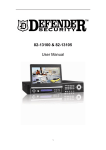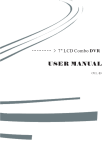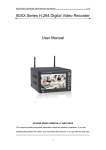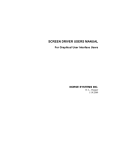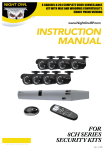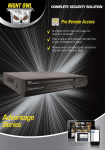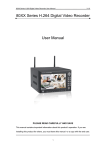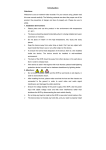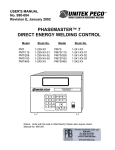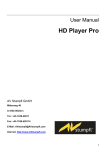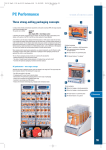Download H.264 standalone DVR User Manual-G Series(960H)
Transcript
H.264 Digital Video Recorder Operation Instruction Statement: Copyright ©2013 Any extraction, reproduction or distribution of this manual in part or in whole by any company or any individual is prohibited without written consent of our company. The content of this manual will be updated at any time without notice as a result of product version upgrade or other reasons. Except otherwise specified, this manual is only used for application guidance, and all descriptions, information and recommendation in this manual will not constitute any expressed or implied warranty. 2 Precautions 1. This video recorder is powered by utility power through DC12V adapter, please check the power supply of power socket to see if it meets the requirement of the adapter before installation is carried out; 2. Never place the video recorder at humid place or place subject to rain; 3. The video recorder should be installed at a place without strong vibration; 4. The video recorder should be installed at a place without direct sunlight and far away from heat source and high temperature; 5. When the video recorder is installed, its rear panel should be more than 15cm away from other object or wall to facilitate heat emission by fan; 6. Allow the video recorder to work within the temperature, humidity, and voltage ranges permitted by the technical criteria; 7. Never store chemicals from which corrosive and volatile gas may be created in the place where the video recorder is installed, lest the service life of video recorder will be affected; 8. The video recorder should not installed where there are many dusts, and the surrounding environment should be kept clean; 9. When the video recorder is used, correct grounding should be ensured; 10. When the video recorder is installed, correct connection to other devices should be ensured; 11. Please purchase hard disk from formal channel, so as to suit long term, mass data read-write requirement of DVR; 3 Contents Chapter I: Introduction .................................................................................................................................... 6! 1.1 Main features..................................................................................................................................... 6! 1.2 Product features................................................................................................................................. 6! 1.2.1 Performance parameters ......................................................................................................... 6! Chapter II: Environmental adaptation ............................................................................................................. 8! Chapter III: Operation manual of main frame ................................................................................................ 9! 3.1 Remote control .................................................................................................................................. 9! 3.2 Mouse operation .............................................................................................................................. 10! 3.3 System operation ............................................................................................................................. 11! 3.3.1 User login ............................................................................................................................. 11! 3.3.2 The right mouse button operating instructions .................................................................... 12! 3.3.3 Menu operation .................................................................................................................... 13! 3.34. Display Setup ....................................................................................................................... 13! 3.3.5 Record setting ...................................................................................................................... 16! 3.3.6 Network setting .................................................................................................................... 18! 3.3.7 Record Search, playback and backup .................................................................................. 24! 3.3.8 Device management ............................................................................................................. 30! 3.3.9 System function.................................................................................................................... 37! Chapter IV: Network control and management at PC end............................................................................ 43! 4.1 Remote access setting ..................................................................................................................... 43! 4.1.1 Network security level setting.............................................................................................. 43! 4.1.2 Connection setting................................................................................................................ 45! 4.2 Functional characteristics ................................................................................................................ 47! 4.3 Constraint condition ........................................................................................................................ 47! 4.4 User login ........................................................................................................................................ 47! 4.5 Interface operation .......................................................................................................................... 49! 4.5.1 Real time preview ................................................................................................................ 49! 4.5.2 Record playback ................................................................................................................... 51! 4.5.3 Remote setting...................................................................................................................... 54! 4.5.4 Local setting ......................................................................................................................... 64! 4.5.5 Log-off and exit ................................................................................................................... 64! Chapter V: DVR installation guidance ......................................................................................................... 64! 5.1 Definition for interfaces of front and rear panels ............................................................................ 64! 5.1.1 Definition for interfaces of front panel ................................................................................ 64! Remark: Different model of DVR with different number of key on the front board .while the same function key. ........................................................................................................................ 65! 5.1.2 Definition for interfaces of rear pane ................................................................................... 65! Remark:Different model of DVR with different interface on the rear board, while usually the same function of the interface ....................................................................................................... 66! 5.2 Alarm post interface ........................................................................................................................ 67! 5.2.1 Alarm interface definition diagram ...................................................................................... 67! 5.2.2 Alarm input and output ........................................................................................................ 67! 5.2.2 Wiring diagram of alarm output........................................................................................... 67! 5.3 Hard disk installation ...................................................................................................................... 68! Chapter VI: FAQ ........................................................................................................................................... 70! Chapter VII: APPENDIX.............................................................................................................................. 74! Appendix 1 E-Video .......................................................................................................................... 74! 4 Foreword Introduction This manual provide a using guide and specifications of 4/8/16 ch standalone Digital Video Recorder with detailed description of the function of each model and precautions as well as signal definitions of the connectors in the rear board Chapter I . Product Introduction. Product functions, main features and environmental adaptation are briefly introduced. Chapter II Environmental adaptation. Chapter III Operation manual of main frame. Including functional introduction for the press keys of remote control, and the operation function corresponding to each menu interface and the meaning of each option setting are explained in details. Chapter IV Remote monitoring software. The operation function corresponding to each IE menu interface and the meaning of each option setting are explained in details. Chapter V DVR installation guidance. Signal arrangement and connectors of rear panel are detailed; the definition for the signal of each external cable; the definition of front panel and the definition of each interface are also detailed. Chapter VI FAQ. 5 Chapter I: Introduction 1.1 Main features This DVR Series are 960H high resolution Digital Video Recorder with 4CH /8CH /16CH real tim e. With the function of real-time monitoring, recording, playback Support triple stream, data bac kup, motion detection and USB mouse etc. 1.2 Product features ! Video compression format is standard H.264 ! Two USB interfaces ! 16-bit true color translucent graphic menu interface, menu option notation prompt ! 4 / 8 / 16 channel synchronous playback ! Two-stage user authority management ! Support multi-Video real time browse, parameter setting, backup or record playback to local device by network 1.2.1 Performance parameters 1. HDMI series 4CH 8CH and 16CH parameter Model Compression video input Video output Resolution 4CH 8CH 16CH H.264 1.0Vp-p/75Ω BNC×4 1.0Vp-p/75Ω 1.0Vp-p/75Ω VGA×1; HDMI×1 BNC×1 BNC×8 1.0Vp-p/75Ω BNC×16 Live Display 960H Recorder 4CH 960H real time RCA 4 RCA 1 G.711A Live Display 960H Recorder 8CH 960H real time RCA 8 Live Display 960H Recorder 16CH 960H real time RCA 16 Alarm in put 4 CH in 8 CH in 16 CH in Alarm out put 1 CH out 3 CH out 3 CH out Audio in put Audio out put Audio encoding and decoding Recording mode Multiplex Network interface PTZ control Manual recording alarm recording record playback Scheduled recording motion detection and external network RJ45(10M/100M self-adaption) Yes 6 RJ45(10M/100M/1000 M self-adaption) Serial Interface RS485×1 Storage 2 SATA HDD Mouse Remote control Adaptor 2. Basic 12V/5A • Video resistance • Audio output • HDD SATA • interface Temperature • • I/O interface • • input • • 12V/5A RS232 interface RS485 interface 12V Introduction 75 • • • direct current 12V Each ch Video input resistance 75 1Vp-p • Out put 1Vp-p • • • CVBSAnalog signal -10----50 0—2V • SATA interface Support Mainstream capacity SATA HDD Ambient temperature under a well-ventilated condition. For low level alarm 5V-30v • For the high level alarm. Serial • • Aside serial interface Serial • • Support protocol • • 12V/5A Work parameter input voltage • HDD parameter • • 2/4 SATA 300GB-2TB 300GB-2TB USB mouse Yes Item • USB2.0×2 7 for extend RS232 device Pelco-D Pelco-P and so on Chapter II: Environmental adaptation In order to ensure safe application of DVR and obtain satisfactory service performance, prolong the service life of device, customer should fully consider the following factors when install the device: 1) When the device is installed and operated, all specifications of electronic product and the requirements of vehicle and other connecting device should be followed. 2) Power supply and grounding: " Never use wet hand to touch power supply and video recorder. " Never drop liquid on video recorder, otherwise short circuit inside device or fire may be resulted. " Never pile other object on video recorder. " Use soft dry cloth to clean video recorder, never use chemical solvents. " After the power cable of video recorder is connected to power socket, there is still voltage inside the device even if the video recorder has not been started. " If the device is not to be used for long term, it is preferred to fully disconnect the power supply of video recorder, and unplug the power cable from the power socket. 8 Prompt: when using remote control to input password and camera name, please use the key area to press Enter key, and then press Numbers key. Chapter III: Operation manual of main frame In the operation of this device, the Enter key on remote control has the same function as the left click of mouse. 3.1 Remote control Remote control is a minor input device to browse system interface. The usage of function keys of remote control: 1. Standby: standby mode; 2. Login/lock: Remote control can control the device through the device number is landing, Locked shielded remote control equipment 3. Number keys or video channel buttons: pressing number key 0~9 in setting interface means the input of number 0~9; in monitoring state, pressing number key means switching the output Video to video single Video of each channel; 4. Multi-Video: switch output Video to 4-channel video Video or multi-channel video display; 5. Menu: press this key in preview picture to display main menu; 6. PTZ: call out PTZ control interface; 7. ESC: close menu window or return to previous menu; 8. Browse or Enter: ·▲ Press to move mouse cursor upwards in menu interface, and add 1 for video channel value · Press to move mouse cursor rightwards in menu interface, and add 1 for video channel value, in playback, 2X, 4X, 8X, 16X, 32X speed fast play is supported; · Press to move mouse cursor leftwards in menu interface, and minus 1 for video channel value, in playback, 2X, 4X, 8X, 16X, 32X speed fast backward is supported; Figure 3.1 remote control · Press to move mouse cursor downwards in menu interface, and minus 1 for video channel value; · Enter: It is used to confirm the selection and setting of system parameters, playback etc operations; 9.+/-: It is used to adjust analogue quantity parameters, increase/ decrease parameter value of system setting parameter; 10. Record: enable manual record; 11. Stop record: stop manual record; (this function can’t stop starting record or timing record being carried out) 12. Auxiliary: preserved key; 13. Playback control: · Fast backward: fast play back Video backwards, support 2X, 4X, 8X, 16X, 32X speed fast backward; press key to restore normal playback speed; · · press Play: it is used to play back record data in normal speed; Fast forward: fast play back Video forwards, support 2X, 4X, 8X, 16X, 32X speed fast play; key to restore normal playback speed; · Slow play: play back Video in slow speed, support 1/2, 1/4, 1/8, 1/16, speed slow play; press 9 key to restore normal playback speed; · Pause/play frame by frame: pause or play back Video frame by frame; press firstly to pause the playback of Video; then press continuously, each press will play back 1 frame of Video; press key to restore normal playback speed; 14. Sound control: enable and disable sound. Select device number setting by remote control: after number in Password setting Login/lock key is pressed, input device to control the device. For example: select the device with device number of “000001”. After Login/lock key is pressed, input number “1” (that is Login/lock ), then the remote control can control the machine with device number of “000001”. Note: when the device number is 000000, the remote control can control by default, Login/lock +0, the remote control can control machine with any number The number of machine can be set as up to 000255 3.2 Mouse operation Mouse is the main input device to browse system menu. Note: except stated otherwise, all system functions in this manual are described by using mouse input operation. Mouse application of this system: 1 Insert USB mouse to the USB mouse port on the front panel of this system or the USB interface at the bottom of rear panel. Figure3.2 Connect USB mouse to the bottom USB port of rear panel 2) The operation of mouse key is as follow: ·Left key: single click left mouse key on the functional menu option icon to enter the setting page of the menu; double click left mouse key in real time monitoring Video or playback Video will zoom in the image of certain channel, double click left key again to return to the monitoring and playback of multi-channel Video. ·Right key: in real time preview Video, single click right mouse key to enter the main menu of system. In menu page, single click right mouse key to return to previous page. 3 Roller in the middle of mouse: No function at all. 10 Figure 3.2.1 Mouse key operation Virtual keyboard (mouse operation) Application of virtual keyboard: 1 Click input box, such as user number and user password box. 2 Click the corresponding number of 0~9 key input. 3 Left click to switch input methods: digit, capital letter, small letter, punctuation character and Pinyin input method (different input method switch available depending on the property of the input box). Figure 3.2.2 virtual keyboard 4 Left click to delete character. 5 Click key to conform/input and close virtual keyboard. Note: when mouse cursor moves to the selected button, the keyboard button will be shown in orange. 3.3 System operation 3.3.1 User login 1. Start the system Power ON/OFF: Connect power cable to the DC12V port on the rear panel of this system. When the system is started, it will execute a basic system inspection and run initial load sequence. After few minutes, the system will load real time display diagram. Password Note: the system will enable password by default. You can disable it manually in password setting. The default password is: 123456. Note: 1 When the main frame is powered on, if no hard disk is installed on the device, or the installed hard disk is not detected during starting up, or the installed hard disk hasn’t been formatted on the local device, 2 H mark will be displayed on video preview Video after starting up. Newly installed hard disk can be used normally only after being formatted through local device. New hard disk can be detected automatically during starting up and it will prompt you to format hard disk; if it is required to format hard disk in the system, the procedure is as follow: main menu>hard management>format hard disk. 2. System login Open main menu: right click any position on screen to display toolbar, select the first main menu button (mouse operation) at the left most of toolbar, or press [MENU] on remote control or panel to enter into login box, as shown below: 11 User name: user can select your user name in the pull-down box of user name. If it is required to enable other user to log in, please use admin to log in and enter: main menu > system function > user password, so as to open other account. User password: input the corresponding password of the user Note: the system has enabled password by default, when the system is entered at each startup, only after the corresponding password is entered according to the user name, the system can be entered. (The default password for admin is 123456) or general user password (the default password for system general user1 is: 123456) 3.3.2 The right mouse button operating instructions 1. Cl i c k t he r i ght mous e but t on i nt o t he r i ght me nu 12 3.3.3 Menu operation Main menu consists of DISPLAY , RECORD , NETWORK , DEVICB , SYSTEM items, as shown below: Prompt: the settings to all submenus below are valid only after Apply is pressed; The settings are invalid when you exit this page directly without pressing OK. This product has an obvious feature: when mouse cursor moves to any option, the remark prompt information of the option will be displayed automatically at the bottom of the interface. 3.34. Display Setup Display Move mouse cursor to Display item, single left click mouse to enter the setting interface of the item. As shown below: 13 CH01-CH08: click to pop up pull-down box to switch to other channel to carry out setting Name: move mouse cursor to the channel name to be modified, single left click mouse to pop up soft keyboard so as to modify channel name. Convert: “Open” means the Video of the channel can be seen on video preview Video. Position: left click the pull down menu for the channel where the name position is required to be modified, there are 5 setting options: left-top, left-bottom, right-top, right-bottom and close. Color: move mouse cursor the Setup of corresponding channel, single click mouse to enter the setting interface of color, as shown below: Drag mouse cursor to carry out the setting of Video color, including 4 options: Hue, bright, contrast and saturation. Click Copy Setting Apply to exit and the set parameters are saved. Will a channel set parameters copied to the other channels. 2. Time setting Move mouse cursor to Date/Time item , single left click mouse to enter the setting interface of the item. As shown below: 14 Ti me Zone Press keys are used to the time zone switching, please choose where you are and the corresponding time zone Date/Time Format: Pr es s Key t o t i me f or mat of s wi t chi ng, MM/ DD/ YY, YY- MM- DD and DD/ MM/ YY t hr ee opt i ons . You can choos e 24 hour s 12 hour s t o make. Date/date set: Modification date and time, Click on the apply after the modification effect. Change may cause video file is missing, recommend that users don't easily modified time. NTP: Open/close, mainly used for time synchronization, opening NTP after the system automatic correction DVR time. Server: The server for the default, may not be installed Li ve Pr evi ew s cr een t i me on/ of f Re c or d Vi deo s cr een t i me s t ack on/ of f 4 .System language Move mouse cursor to Language item, single left click mouse to enter the setting interface of the item. As shown below: 15 There are multiple options in system language: Chinese, English, Portuguese and so on. Note: the system will restart after system language is modified. 3.3.5 Record setting 1. Record setting Move mouse cursor to Record item , single left click mouse to enter the setting interface of the item (as shown below). 16 CH01-CH04/CH09-CH16: click the button to switch to other channel to carry out setting. Record: “Open” means the record function of corresponding record channel is enabled. Quality: there are 3 types: excellent, good and medium corresponding to 3 data stream standards: very high bit rate, higher bit rate and medium bit rate. Resolution: 960H( D1) HD1 CIF optional some models only with CIF and D1 Audio: “Open” means all channels have audio recording enabled; “Close” means all channels have audio recording disabled. FPS Set t he number of f r ames per s econd vi deo, P s ys t em: 1 f r ame/ s econds - 25 f r ames per s econd can choos e; N s ys t em: 1 f r ame/ s econds - 30 f r ames per s econd can choos e Schedule Setup Move mouse cursor to Schedule item , single left click mouse to enter the setting interface of the item (as shown below). Mode: there 2 methods: Always and Schedule. ● Always: the record is started when the device is powered on. ● Schedule: Vi deo of vi deo s et accor di ng t o pl an 17 As shown below: Channel: you can select All channels , you can also select single channel. Record Schedule Setup: firstly select the record method configuration carried out aiming at certain pane; there are 3 types of option: alarm record, conventional record and no record; so as to carry out configuration to specific record time pane (each pane represents 1 hour). Each pane can be configured as different record method, which represents as different color marked on each pane: red, green, base color that represents alarm record, conventional record and no record respectively within the hour. Packing time: single left click its pull down menu to carry out selection of packing time, there are 4 options: 15 minutes, 30 minutes, 45 minutes, and 60 minutes. Event Setting Configuration alarm event video parameters, please refer to the video Settings. 3.3.6 Network setting 1. Network setting Move mouse cursor to Network item, single left click mouse to enter the setting interface of the item. As shown below: 18 Address type: there are 3 types of optional address: DHCP, PPPOE, Static IP (manual configure) # Static IP Press Select static IP in Address type to enter manual static IP, as shown above. Media port: port number adopted by private communication protocol between DVR device and PC end; in general case, the default value is: 8200. If the port on PC is occupied by other service, please change it to an idle port. (This port is not required to be added if accessing the device through P2P platform) WEB port: HTTP port, in general, default value is adopted: 80. If administrator has change the WEB port to other port such as: 8235, then add port number after IP, when it is required to access the device through IE, input in address field: http://192.168.60.176:4760. (This port is not required to be added if accessing the device through P2P platform) IP address: fill in IP address according to the network where the device is located. Subnet mask: fill in subnet mask according to the network where the device is located. Gateway: set gateway according to the network where the device is located. If there is no router device in the network, please configure IP address of the same network segment; if there is router device in the network, then it is required to set well corresponding gateway. P2P: Input the network ID of P2P which is unique to each machine. When the system is available for P2P, people can get remote access to DVR through mobile client and CMS client without adding or mapping DVR’s network port, which is easy and convenient to use. Methods of using P2P Method one: get access through the network ID. under the situation that normal operation of the DVR network can be guaranteed, the remote access to DVR can be realized by adding the P2P device (mobile 19 phones can make it by scanning QR codes) through CMS client or mobile client without adding any ports. Method two: get access through my E horizon domain name. Under the situation that P2P is available for the front-end DVR, the network ID of P2P would be bound to the E horizon domain name, and then remote access to DVR can be realized directly through the E horizon domain name on the client side or IE. # DHCP Select DHCP in address type to enter its setting interface, as shown below: Media port: it is the same as static IP WEB port: it is the same as static IP Note: after DHCP method is selected, restarts the system after confirm. After startup, the system will automatically establish connection with DHCP server; after the connection is successful, the device will be configured with an IP address and displayed on the interface. # PPPOE Select PPPOE in address type to enter its setting interface, as shown below: 20 Media port: it is the same as static IP WEB port: it is the same as static IP PPPOE user name and password: fill in PPPOE user name and password provided by internet service supplier, restarts the system after confirm. After startup, the system will automatically establish network connection in PPPOE method; after the connection is successful, the IP on IP address will be automatically modified as dynamic IP address obtained on WAN. DNS: set the IP address of domain name server; refer to the configuration of domain name server on computer. 2. DDNS setting Move mouse cursor to DDNS item, single left click mouse to enter the setting interface of the item. As shown below: 21 DDNS: there are 2 options: Open/Close ; You can select DDNS Enabled when there is domain name resolution server. Server: user can select required DDNS server, there are 4options: 3322, dyndns, nightowldvr, no-ip; Registration and method of use see appendix 1 Host Name: input the host name registered on dynamic domain name resolution server. User name: input user name registered on dynamic domain name resolution server. Password: input password registered on dynamic domain name resolution server. E-Video The user can review the DVR IE from http://www.dvripc.net directly. (For more operation step please refer to Chapter VII appendix) 3. Mobile phone monitoring Move mouse cursor to Mobile icon, single left click mouse to enter the setting interface of mobile phone monitoring; if it is required to input user name and user password in mobile phone software, then the corresponding user name and password should be consistent with the user name and password of IE setting, the default user name is: admin, the corresponding password is: 123456. As shown below: 22 Service port: port number adopted by private protocol communication between DVR device and mobile phone; in general condition, default value is adopted: 15961. If the port of mobile phone is occupied by other service, then change it to an idle port. Mobile Stream remark Choose by your network environment The installation guide of Mobile phone software is enclosed in CD 4. Email Setup Move mouse cursor to E-mail item, single left click mouse to enter the setting interface of the item. As shown below: 23 SSL Except for Gmail that should be set ON, it is set as OFF for other mailbox. SMTP port It is 465 for Gmail, and 25 for other mailbox. SMTP server It is generally: smtp.xxx.com, such as smtp.gmail.com, smtp.sina.com. Sender Mail Corresponding mailbox address of above SMTP server Sender PW Password of above mailbox Receiver mail Mailbox address of receiver Interval Time interval of sending alarm email, options are: 3 min, 5 min and 10 min. The system will capture the image and send to your setting mailbox when motion detection alarm 3.3.7 Record Search, playback and backup 1. Search and playback Click the right button of mouse Select the "search" button Enter the file search to search the event record data, select event in the type The f i r s t : f i l e s ear ch 24 interface If you want Us er s t o s et up Sear ch t er ms , cl i ck on t he Sear ch but t on Sear ch out vi deo f i l es , as t he char t Mous e t he l ef t key cl i ck vi deo f i l es can pl ay The s econd event s ear ch you can s ear ch f ul l event i nf or mat i on and t he al ar m event i nf or mat i on f or wi t hi n t he day t he s ame oper at i on wi t h t he f i l e s ear ch 25 2. Video files backup operation Cl i ck t he r i ght mous e but t on choi ce backup but t on t o ent er t he vi deo backup s ear ch i nt er f ace, Vi deo f i l es backup t hr ough USB s t or age devi ces can be copi ed or acces s equi pment means , Can accor di ng t o t he f i l e backup, ca n al s o accor di ng t o t he t i me t he backup. I n t he vi deo f i l es backup bef or e, t he us er mus t f i r s t wi l l s t or age per i pher al s i ns er t ed i nt o t he devi ce USB2. 0 s l ot or connect ed t o t he r ecor di ng equi pment , t hi s pr oduct s uppor t USB pl ug and pl ay equi pment oper at i on. When USB s t or age devi ces and bur n equi pment and acces s DVR, s ys t em pr i or i t y backup t o bur n equi pment , Backup s ear ch i nt er f ace i s s hown bel ow Cal endar : cl i ck on t he Cal endar , i nt o t he pl ayback s ear ch i nt er f ace, vi deo pl ayback. Backup s ear ch condi t i ons , i ncl udi ng: t i me, t he channel , t ype. Set up t he Sear ch t er ms , cl i ck on t he Sear ch but t on, wi l l Sear ch t he vi deo f i l es t o l i s t ar e f or m, cont ent . 26 bel ow I n det ai l ed l i s t i nt er f ace f i l e on a choi ce f or a vi deo f i l es , i n t he s el ect i on box cl i ck t he mous e l ef t key af t er , t hi s box wi l l be t he emer gence of a " appr opr i at e" , s ai d t he vi deo f i l es ar e s el ect ed, t o move t he mous e t o t he backup backup but t on and cl i ck t he but t on, r i ght now t he i nt er f ace may di s pl ay f i l e backup s chedul e i nf or mat i on, s ee bel ow 27 Note: 1 If the space of backup device is less than the capacity of the record file, then when user carry out backup, the system will prompt: not enough space; 2 After the backup of record file is completed, directly pull out the backup device. 3. Video playback Click the right mouse button, and click the “video playback” button to enter the interface for video playback, as shown below, and then click the button or single click the mouse on the progress bar for playback to start playing the video. 28 Directions: Playing status: represent the status of the video files playing. There are six statuses including fast forward, fast backward, slow play, frame forward, normal play and play stop. The playing status can be switched through clicking the buttons on the playback toolbar or the front panel. Calendar: the play-date can be chosen through the calendar. Only under the status of play stop can the date be chosen. Image division: get playback by choosing different approaches or different channels. Single-image, four-image, eight-image and sixteen-image are available to be chosen according to the requirements and performances. Channel selection: different channels would be chosen during single-image, four-image and eight-image playback. The progress bar for playback: it refers to the schedule during the course of video playing. The selected moment can be quickly jumped to by dragging the progress bar. The accuracy selection of the progress bar: different accurate schedule can be chosen based on division of twenty-four hours, two hours, one hour and thirty minutes. Audio adjustment: adjust the size of voice frequency during the video playback. Playing status switching: from left to right, the buttons on the toolbar in sequence are fast backward, slow play, normal play, pause/frame forward, fast forward and play stop. Digital zoom: digital zoom can be operated when the video is played in single-image or the single-image is zoomed in by double clicking the channel. 29 Direction: only under status of play stop can the calendar, image division choosing and channel selection be operated. 3.3.8 Device management Move mouse cursor to Device icon , single left click mouse to enter the interface of the item (as the Advanced function includes 6 items: hard disk management, alarm setting, mobile phone monitoring, motion detection, PTZ setting and exit. 1. Hard disk management Move mouse cursor to HDD item , single left click mouse to enter the setting interface of the item (as shown below). 30 Information: there are 3 states: normal, unformatted and no hard disk; if all hard disks do not work normally (including unformatted and no hard disk states), a symbol H will be displayed on video preview interface. Total/Avail: indicate total capacity and current available capacity on hard disk. Avail time: indicate the time available for recording on current hard disk. Select: ticked indicate that the selected number of hard disk will be formatted. Overwrite: Automatic: when the residual space of hard disk is less than 10G, the earliest 2G record file on hard disk will be deleted; Close: when the residual space of hard disk is less than certain space, then stop recording; 1 hour: only keep the latest 1 hour record file; 3 hours: only keep the latest 3 hours record file; 1 day: only keep the latest 1 day record file; 7 days: only keep the latest 7 days record file; 30 days: only keep the latest 30 days record file; 90 days: only keep the latest 90 days record file. Format HDD: carry out hard disk format to the ticked hard disk, single format can be carried out. Format USB: move mouse cursor on this button and press OK key to format U-disk. Note: hard disk format and U-disk format will clear all data, please back up your important data. 2. Alarm setting Move mouse cursor to Alarm icon, single left click mouse to enter the interface of the item (as shown below): 31 CH01-CH04 Click to pop up pull-down box to switch to other channel to carry out setting. I/O Alarm: each channel corresponds to an I/O state alarm, that is, when the IO input of certain channel is valid, start the alarm record of corresponding channel. NO (Normal open): indicate that external alarm circuit is open circuit normally; it is closed circuit when there is alarm. NC (Normal close): indicate that external alarm circuit is closed circuit normally; it is open circuit when there is alarm. HDD Loss: Enabled indicates that when the system can’t identify hard disk, an alarm will be created; H will be displayed at the left bottom of channel 1 in video preview Video. NO Space: Enabled indicates that when the residual space of hard disk is less than 10G, an alarm will be created. Video loss: Enabled indicates that when video loss occurred at certain channel, the channel in video preview Video will display: video loss Alarm control: there are 4 items: alarm output, buzzer, record time length and prerecording time. # output: time for external output of alarm signal by DVR when alarm occurs. Options are: close, 10 sec, 20 sec, 40 sec and 60 sec. # Buzzer: time for the sounding of buzzer when alarm occurs. Options are: close, 10 sec, 20 sec, 40 sec and 60 sec. # Duration: time to prolong recording after alarm ends. Options are: 30 sec, 1 min and 5 min. # Pre Rec: enable and disable alarm prerecording. 32 3. PTZ setting Move mouse cursor to PTZ item, single left click mouse to enter the setting interface of the item (as shown below). Each parameter of each channel can be set individually. Channel: select the channel where ball machine camera is connected. Protocol: select ball machine protocol of corresponding brand type, there are 12 optional protocols. Baud rate: select the baud rate used by corresponding ball machine, there are 8 optional baud rates: 1200, 2400, 4800, 9600, 19200, 38400, 57600, 115200. Data bit: there are 4 options: 5, 6, 7, 8, the default is 8. Stop bit: there are 2 options: 1, 2, the default is 1. Parity: there are 5 options: None/Odd/Even/Mark/Space, the default is None. Cruise: ON means automatic cruise function is enabled. Address: fill in the PTZ code of corresponding channel. PTZ control Click PTZ button of toolbar to enter the interface of PTZ control. As shown in figure 3.7.4: 33 Figure 3.7.4 PTZ control The buttons for PTZ operation are shown in the following table: All Functions Pointer Auto Pan To select the direction of PTZ The middle circle is for auto pan of PTZ. Zoom in/zoom out Focus 34 Iris Volume PTZ control the speed Channel select For selecting the channels of PTZ camera. Go to preset point Allow you to go to a specific preset point. Set Point Allow you set a set of specific preset points of a PTZ camera. Also it can Adjust the camera in a fix point. Allow you to delete the selected preset Clear Cur Point Hold time It indicates the starting point cruised. System default point is 01. Sets the stop time at each point Save Save the changed and the preset point.2 Table 1.3 PTZ control buttons Automatic cruise (PTZ) Enable automatic cruise in PTZ setting. Corresponding channel all set up the right mouse button at the preset began to be automatic cruise, Automatic cruise open and set up the channel access to preset point cruise states. Set up automatic cruise the preset point, Need to check the preset away old pan and tilt, And then reset preset points, Can automatic cruise. 35 5. Motion detection Move mouse cursor to Motion detection icon (white boxed icon means selected), single left click mouse to enter the setting interface of motion detection, as shown below: 36 CH01-CH04: click to pop up pull-down box to switch to other channel to carry out setting. Chn: corresponding channel switch of each channel, you can select to enable or disable motion detection. Sensitivity: corresponding channel sensitivity setting of each channel, there are 4 standards: highest, high, medium, and low. Area: each channel has corresponding motion detection zone setting, move mouse cursor to the Setup of corresponding channel, single left click mouse to enter the interface of motion detection zone of this channel; red panes represent motion detection initiated in this zone, transparent panes represent motion detection not initiated, as shown below: You can press mouse left key and drag to select the zone of motion detection, after the selection of zone is completed, single click right mouse to exit and return to Motion detection interface, click OK to complete the setting. Prompt of operation: Remote control operation: use Menu key to select the zone. 3.3.9 System function Move mouse cursor to SYSTEM item, single left click mouse to enter the setting interface of the item. As shown below: 37 System function consists of 4 options: system information, user password, audio-video, and system maintenance (device maintenance). 1. system information Move mouse cursor to Information item (white boxed icon means selected), single left click mouse to enter system information interface. As shown below: 38 Expor t I ns er t U di s k, s ys t em conf i gur at i on par amet er s can be i mpor t ed t o U di s k, U di s h i n t he r oot di r ect or y wi l l aut omat i cal l y gener at e a s ys par am f i l es I mpor t Put t he Sys par am f i l es t o U di s k r oot di r ect or y and i ns er t U di s k, t he s ys t em conf i gur at i on par amet er s wi l l i mpor t t o DVR Sys t em Log: Log inquires, Inquires the alarm information, System operation information, DVR start information. Log Search: Type has al l , al ar m, t he oper at i on of t hr ee opt i ons . Al ar m l og r ecor ds , mobi l e det ect i on, vi deo I O l os t , har d di s k dr awback of al ar mi nf or mat i on, oper at i on j our nal r ecor d par amet er s modi f i cat i on, equi pment t o r es t ar t and ot her i nf or mat i on. I nput t he i nqui r e " s t ar t t i me" , " t he end of t i me" , cl i ck s t ar t af t er t he s ear ch, t he cont ent of t he s ear ch i n t he f or m of aut omat i c l i s t s hows . See char t ; 39 Cl i ck on t he Expor t but wi l l l og i nf or mat i on t o not epad f i l e Expor t t o U di s k, us ed t o open a t abl et comput er 2. User password Move mouse cursor to Password item, single left click mouse to enter the setting interface of the item. As shown below: 40 De vi c e I D: di r e c t pr e s s t he numbe r ke ys f or e qui pme nt Numbe r s s e t t i ng. Se t good e qui pme nt Numbe r s , r e mot e c ont r ol ne e ds t o e nt e r l andi ng/ l oc ki ng + e qui pme nt Numbe r s , c or r e s pondi ng t o t he mac hi ne c ont r ol , ( s e e c hapt e r 3 i nt r oduc t i on of r e mot e c ont r ol ) Pas s wor d: t he on/ of f . Cl os e s ai d not ne e d pas s wor d DVR l andi ng, t he pr opos al doe s not s hut down t he pas s wor d. Admi n: admi ni s t r at or us e r s , t he hi ghe s t aut hor i t y, al l of t he ope r at i ng s ys t e m. Us e r 1- Us e r 4 Normal user User permission PTZ control Permissions configured by the admin Refers to the authority to control PTZ parameter setting system maintenance Refers to modify the system parameter setting Refers to the authority of the system maintained such as upgrade, format setting Move mouse cursor to Audio-video item, single left click mouse to enter the setting interface of the item. As shown below: 41 video Signal: there are 2 options: PAL system and NTSC system. Sequence time: time interval of polling Video; when the time is set as 0, video output has no polling; after the default is restored, the polling time of the channel is 5 sec. VGA Resolution: there are 5 options: 800 600 1280 1024 1024 768 1920 1080 1440 900 Screensavers time The system Set locking time automatically Interface transparency Adjusting the transparency of the menu interface Volume: move mouse cursor to Volume , single click to enter the interface of volume adjust, directly drag mouse cursor to adjust volume. Note: the system will restart after camera system is modified. Margin adjust: move mouse cursor to Margin , single click to enter the interface of margin adjust, use mouse to drag process bar to adjust top, bottom, left and right margins of multi-Video. 4. System maintenance Move mouse cursor to Maintain item, single left click mouse to enter the setting interface of system maintenance, as shown below: 42 Auto Maintain: when the item is set as “Enable”, user can set the restart time of device. Upgrade: Wi l l upgr ade f i l e copy t o U pl at e " dvr upgr ade" f ol der l i s t , agai n wi l l U pl at e i ns er t ed i nt o t he devi ce USB s l ot , t he conf i r mat i on t hi s but t on, car r i es on t he s ys t em upgr ade Load Default: restore system parameters to factory default state. Reboot: click this button to restart the device. Power Off: click this button to pop up a prompt box of safe shutdown, click OK to shutdown. Note: ensure the stability of U-disk and power supply during the process of upgrade. Chapter IV: Network control and management at PC end 4.1 Remote access setting 4.1.1 Network security level setting Before controls are installed, please set network security level, which is detailed as follow: 1 Open IE browser, select “Internet Options” of “Tool” menu. 2 Select “Security” tab in the dialog box appeared. (Figure 4-1) 43 Figure 4-1 3 Click “Custom Level” to enter Security Settings. (Figure 4-2) Figure 4-2 Set ActiveX controls and plug-ins 1) Automatic prompting for ActiveX controls 2) Script ActiveX controls marked safe for scripting 44 3) Initialize and script ActiveX controls not marked as safe 4) Binary and script behaviors 5) Download unsigned ActiveX controls 6) Download signed ActiveX controls 7) Run ActiveX controls and plug-ins Set above items as “Enable”, this is very important. Prompt: before controls are installed, please close fire wall and virus-killing software. 4.1.2 Connection setting The remote access of hard disk video recorder is carried out through network; when LAN connection is used, the IP addresses of client end computer and hard disk video recorder should be within the same network segment; when WAN connection is used, connection can be realized through IP address or dynamic domain name, ensure that both sides can access the public network. The connection setting method of LAN is mainly introduced as follow. Step 1: right click “Network Neighborhood”, click “Property” in pop up menu, so as to open “Network Connection”. Step 2: double click to open “Local Area Connection”. (Figure 4-3) Figure 4-3 Step 3: click “Property”. (Figure 4-4) 45 Figure 4-4 Step 4: double click “Internet Protocol (TCP/IP)”. (Figure 4-5) Figure 4-5 Step 5: examine IP address, subnet mask, default gateway on PC. (The parameters shown in figure 8-5 depend on specific using situation of user) 46 Step 6: set corresponding IP address, subnet mask, default gateway of hard disk video recorder (see section 3.3.5 network setting). Therein the subnet mask and default gateway of hard disk video recorder should be the same as PC, ensure that their IP addresses must be in the same network segment, but the IP address can’t be the same as used IP address, otherwise IP address conflict will be resulted. Take above figure for example, the IP address should be: 192.168.0.X, therein X can’t be 40 or 1 (including other used IP address), and can’t exceed 255, the subnet mask is 255.255.255.0, the gateway is 192.168.0.1. 4.2 Functional characteristics Network operation is used to install software through IE browser of the operation system, which is simple and easy; DVR supports C/S, B/S structure, LAN and WAN access, and supports IP and domain name access at the same time. Support user to modify service port, and support PPPOE, DHCP functions at the same time. 4.3 Constraint condition To make sure that PC connect the DVR stably Recommending ing system and the web browser version of IE7.0 and over. Windows XP Windows 7 operat 4.4 User login Input current IP of the device in IE, if the WEB port number is set as (80), then directly input IP address in IE address field; if the WEB port is modified as a port other than 80, then the port number should be added after IP address; for example: the IP of device is 192.168.1.118, set the port as 8088, then input: http://192.168.60.176:4760 to access the device. Under the condition that the network is connected, IE will prompt you to install control to be downloaded to your PC, as shown below: 47 Figure 4-6 This process may last 1~2 minutes depending on network status. The download may not be successful because of PC configuration problem, please click: “ ”. “If your browser does not support the ActivX to download, please click here” means “If your browser does not support the ActiveX to download, please click here”. After the download and installation of control is successful, the login interface will be entered automatically, as shown below: 48 Figure 4-7 You can select between three language interfaces: English/Simplified Chinese/Italian • Five Language optional : English / Chinese / Russian / Spanish / Portuguese User ID and password have admin and normal default admin ID admin password 123456 / normal user ID user password 123456. Different user with corresponding identity and authority and the admin with the highest authority . Network environment: LAN/WAN, select according to the network type of connection between your computer and DVR. After input is completed, click then click to enter the interface of IE end. If the input is wrong, to clear, and input again. 4.5 Interface operation Interface operation consists of 5 items: real time preview, record playback, remote setting, local setting and log-off, click these 5 buttons to switch. 4.5.1 Real time preview Click to enter real time preview interface, as shown below: 49 Figure 4-8 Play control Move mouse cursor to the icon will display corresponding operation prompt. Open all Video. Snapshot picture, and save it on local hard disk, system default save path is C:/DVR. Quickly start the records of all channels, now normal record symbol R will be displayed on the top left corner of each channel, system default save path is C:/DVR. Click icons to carry out switch between /16-Video and, /full screen, /1-Video, / 25-Video /4-Video, /9-Video, / 32-Video Adjust volume button PTZ control It can control PTZ focus, iris, preset positions etc. Click to control PTZ strike upward, downward, leftward, and rightward; because the protocol of some PTZ has slight difference, if the observation direction of PTZ rotates always along this 50 direction when certain direction key is clicked, then click the middle stop key of this icon to stop rotation. 1 .Zoom “+” “-” are used to adjust zoom in and zoom out of lens 2 .Focus “+” “-” are used to realize focus function 3 .Iris “+” “-” are used to adjust the size of iris 4 .Preset position of PTZ is used to set PTZ preset Adjust the following 3 keys: to complete preset of PTZ. Other operation 1 . Select certain channel in preview interface (edge of the channel becomes red means selected), double left click mouse to enter single Video display of the channel. 2 . Left click mouse to select certain channel in preview interface, then right click mouse to display window shortcut operation menu, as shown below: Figure 4-9 Click to quickly close and open the record of the channel. 3 . Single click right mouse at certain place of preview interface, click “Open all windows” and “Close all windows” to quickly open/close all windows. 4.5.2 Record playback Click to enter the interface of record playback, so as to remotely play back historic record in DVR hard disk, up to 16 channels can be played back at the same time, as shown below: 51 Figure 4-10 Click and at right top of the interface to set the month to be searched, click “Refresh” to display the record condition of that month on calendar interface. Therein the date displayed in boldface indicates that there is video recording record on that day; directly click the date to search the record file list of the same day. Select channel and type below the calendar, press “Search” to display the result of search on file list, as shown below: 52 Figure 4-11 Double click certain segment of record on play list to play back this segment of record, the following play buttons will appear during playback. Figure 4-12 The blue process bar shown above displays the process of download, the position of the round white point displays the process of play. Play Pause Stop play Fast forward play Slow play To next frame and pause Playback sound control Capture images Image division and switch 53 4.5.3 Remote setting Click to enter the setting interface; this interface consists of 7 items: code setting, record setting, alarm setting, PTZ control, network setting, advanced setting, and system information. 1. Code setting Click to enter the setting interface of code setting; code setting consists of video parameter setting, audio-video binding and color adjust: click to enter video parameter setting, as shown below: Figure 4-13 Click to enter the setting of audio-video parameters, you can remotely modify the settings of channel name and preview switch and OSD position (channel name position), as shown below: 54 Figure 4-14 Click to enter the setting of color adjust, you can remotely modify the brightness, contrast, saturation, and chromaticity, as shown below: Figure 4-15 when you see ” which you would like to copy. ” button, you can copy the setting to the channel 55 Figure 4-16 2. Record setting Click to enter the setting interface of record mode, as shown below: Figure 4-17 For the setting of parameters, refer to device end. 3. Alarm setting Click , there are 2 types of alarm setting: device level alarm and channel level alarm; click to enter the interface of device level alarm, event types include hard disk failure alarm and hard disk full alarm, as shown below: 56 Figure 4-18 Click to enter the interface of channel level alarm, as shown below: Figure 4-19 For the setting of parameters, refer to device end. 4. Click PTZ setting to enter the interface of PTZ setting, as shown below: 57 Figure 4-20 For the setting of parameters, refer to device end. 5. Click Click Network setting , there are 3 options: wired network, mobile phone network and EMAIL. to enter the setting interface of wired network, as shown below: Figure 4-21 Click to enter the setting interface of mobile phone network, as shown below: 58 Figure 4-22 For the setting of parameters, refer to device end. Click to enter the setting interface of EMAIL, as shown below: Figure 4-23 For the setting of parameters, refer to device end. Click to enter the setting interface of UPNP, as shown below: 59 Figure 4-24 After UPNP is enabled, device IP will be mapped automatically to the router, it is not required to map IP on the router (this function needs the support of router and has UPNP function enabled). 6. Click Advanced setting to enter the interface of advanced setting, which consists of 3 items: system setting, date-time synchronization and system maintenance; click to enter the interface of system setting, as shown below: Figure 4-25 Note: when language and video system are modified, it is required for the front-end equipment to restart to validate. 60 Click to enter the setting interface of system time; you can set time synchronization between the front-end equipment and computer, as shown below: Figure 4-26 Click to enter the setting interface of system maintenance; you can remotely restart and restore factory default setting to front-end equipment, you can also remotely carry out software upgrade to the system, as shown below: Figure 4-27 7. Click System information , then click the first option 61 to enter the interface of version information of system information (as shown below), this interface directly shows device serial number, device type and application version, these information can’t be modified. Figure 4-28 Click to enter the interface of hard disk information (as shown below), this interface directly shows hard disk state, total capacity of hard disk and residual capacity of hard disk etc, these information can’t be modified. Figure 4-29 8. Click User management to enter the interface of user management (as shown below), only admin has the right to add new user and user password and give corresponding authority; all user passwords must be 6 digits. After the password login of front-end equipment is enabled, the newly added user password on 62 IE end can also log in the front-end equipment, so as to synchronize with front-end equipment management setting. Figure 4-30 New User : Step 1. choose new user or change user and password Figure 4-31 Step 2. Enable ON Step 3. Enter new user can not use the same user Step 4. enter the password must be 6 digitals Step 5: Set corresponding limits PTZ CONTROL: control scanning technical parameter in far away place Upgrade format have upgrade and format HDD limit. 63 PARA SET can change the Step 5: Chick “SETUP” button save added user 4.5.4 Local setting Click to enter the interface of local setting, this interface shows local save path for downloaded record, snapshot, and record files on computer end, click display to modify the save path, as shown below: Figure 4-32 4.5.5 Log-off and exit Click button to exit to IE login interface. Chapter V: DVR installation guidance 5.1 Definition for interfaces of front and rear panels 5.1.1 Definition for interfaces of front panel 1. number 1 #29 housing face board buttons definition N Type 1 Turn off 2 Name Introduction POWER Shutdown system REC/STOP Recording control and stop key 64 after the path 2 Function key !! "" Fast forward/backward playback 0 Numbers 9 " Playback /" Playback/play by frame ESC Exit / Previous page "" Slowly playback MENU Main menu PTZ PTZ Control Image division format POWER 3Status light 3 Power light REC Recording LINK On means network has connected ALARM Alarm light HDD FULL 4 5 6 7 4 IR receiver 5 Control button 6 Enter key HDD is fulled IR Remote control receiver Direction ke y direction key include: up left right OK down four buttons. Conform the operation 7USB mouse inte rface USB mouse interface Remark: Different model of DVR with different number of key on the front board .while the same function key. 5.1.2 Definition for interfaces of rear pane 65 Number Physical interface Interface instruction 1 Input power DC 12V 2 Power switch ON/OFF 3 Video input Connect analog video 5A camera signal input Standard BNC connector 4 Audio output Connect audio output 5 Video output One video output connector 6 Audio input Connect audio signal 7 VGA output Connect VGA monitor 8 Net interface Connect to Ethernet 9 USB interface USB2.0/USB mouse 10 Alarm input Connect alarm switch input Alarm output Connect alarm switch input RS485 interface Connect device PTZ and RS485 interface and so on +12V Dc power supply for relay and current 100MA connect TV or monitor standard BNC I/O alarm output Not short circuit 11 Mic audio input Connect Source audio signal 12 HDMI HDMI talkback, Mic input out put Remark:Different model of DVR with different interface on the rear board, while usually the same function of the interface 66 5.2 Alarm post interface Connection method of alarm post: firstly strip the cable to be connected, then use a small screwdriver to jack up orange part, put the cable into the receptacle then loosen the screwdriver to fasten. 5.2.1 Alarm interface definition diagram 1. General 16CHs (Alarm input.Alarm output,RS232 interface,RS485 interface) 5.2.2 Alarm input and output The alarm input can connect to infrared alarm, smoke transducer etc. The alarm input wiring of external power source of detector is shown in the following diagram. 5.2.2 Wiring diagram of alarm output The wiring of external power source of alarm output is shown in the following diagram. Alarm output loop (low level): Wiring diagram of alarm output 67 5.3 Hard disk installation So as to not damage the machine and HDD ,The installation of the HDD should be made by the professional And with the step as follows 1 Take apart the machine cover you will see for fixed 2 take out the HDD fix screw from the accessory box 3 Take out the HDD bracket 4 Install the HDD to the HDD bracket and fix the screw 68 HDD screw hole as the picture below . 5 Fix the HDD bracket after installing the HDD with bracket Attention: After install the HDD should be formatting before using 69 as the picture below Chapter VI: FAQ If the problem you met is not listed in the content below, please contact local customer service personnel or call the customer service of headquarter to consult, we will serve for you with all our heart. 1. Ask: after starting up, digital video recorder can’t start normally? Answer: possible reasons: 2. 1 Input power supply is incorrect 2 The contact of switching power cable is bad 3 Switching power supply is bad 4 Program update is wrong 5 The main board of digital video recorder is bad Ask: digital video recorder will restart automatically or often down several minutes after starting up Answer: possible reasons: 3. 1 Input voltage is unstable or too low 2 Hard disk has bad track or hard disk cable is bad 3 The power of switching power supply is not enough 4 The video signal of front end is unstable 5 Bad ventilation, too much dust, the operating conditions of machine are too severe 6 The contact between main board and other auxiliary board is bad 7 Hardware failure of digital video recorder Ask: single channel, multiple channels, all Video have no output Answer: possible reasons: 1 Please check the power supply connecting camera for loose 2 Please check the connecting wire of video output and input on the rear panel of DVR 3 Directly insert the video source into display device to judge if it is the problem of video source or display device 4. 4 Check image brightness to see if it becomes 0, restore to default setting 5 No video input signal or the signal is too weak 6 Preview closed is set in display setting 7 Hardware failure of digital video recorder Ask: can’t record normally after starting up, a “H” is prompted on the interface Answer: possible reasons: 70 5. 1 Check if DC12V power adapter is adopted by the machine 2 Check if new hard disk has been formatted on the local host 3 The contacts of hard disk power cable, data cable are bad or damaged 4 Hard disk is damaged 5 SATA port of main board is damaged Ask: what’s the meanings of “R” “M” “I” “H” “W” prompted on direct connection picture Answer: 6. 1 “R” means that record is being carried out on the channel 2 “M” means that motion detection is triggered on the channel 3 “I” means that external I/O alarm is triggered on the channel 4 “H” means that the device has no hard disk connected or hard disk failure or disk full 5 “W” means that current system time conflicts with time of record file existed on hard disk Ask: real time image problem, such as video image color, brightness have serious distortion Answer: possible reasons: 1 When BNC is used for output, the selection of PAL system and NTSC system is incorrect, the image will become black and white 7. 2 Digital video recorder and the impedance of monitor not matched 3 Video transmission distance is too long or the fading of video transmission cable is too high 4 The settings of color, brightness etc of digital video recorder are incorrect Ask: no sound in listening Answer: possible reasons: 1 Check if active pickup and active sound box are adopted, you can judge by directly short the signal cables of both 2 Whether the video channel with audio source connected is activated, you can single click the channel to be in full screen to judge 3 8. Hardware failure of digital video recorder Ask: there is sound in monitoring, but no sound in playback Answer: possible reasons: 9. 1 Setting problem: audio record option has not been opened 2 Whether mute is set in playback interface Ask: time display is wrong Answer: possible reasons: 1 Setting is wrong, or the time is modified but “Modify date & time” is not pressed to validate 2 The contact of battery is bad 71 3 10. The service time of battery is too long, please replace the battery Ask: why “Stop record” by clicking right mouse has no function, how to stop record Answer: 1 The “Stop record” key of right mouse is used to stop manual record, it can’t be used to stop the record set in starting record or record schedule 2 If it is required to stop record, please enter into record schedule, set the time interval as no record 11. Ask: motion detection has no function Answer: possible reasons: 12. 1 The setting of motion detection zone is not appropriate 2 The sensitivity is too low Ask: error in DVD/CD rewritable drive/USB device Answer: possible reasons: 13. 1 Data quantity exceeds the capacity of backup device, which will result in CD burning error 2 Backup device is not compatible 3 Backup device is damaged Ask: the remote control can’t control Answer: possible reasons: 14. 1 The address of remote control is wrong 2 The distance of remote control is too far or the angle is too deflective 3 The battery of remote control is used up 4 The remote control is damaged or the front panel of video recorder is damaged Ask: can’t login WEB Answer: possible reasons: 1 Check if the network is connected, check if the LINK or 100M LED on panel displays correctly; use ping xxx.xxx.xxx.xxx (the IP address of the DVR) to check if the network is connected 15. 2 Windows XP or Vista operation system is recommended, IE6.0 or IE7.0 browser is adopted 3 ActiveX control is inhibited, please install ActiveX control manually 4 No dx8.1 or above version is installed, upgrade the driver of display card Ask: there is mosaic in network preview Video and record file playback or no image at all Answer: possible reasons: 1 If DVR is accessed through Internet, when IE is used to login, please select “WAN” in “Network environment”, and select appropriate network bandwidth in “Setting > System 72 setting > Network environment” option. 2 16. Please try right key “Close window”, then “Open window” Ask: when setting is carried out at IE end, why “Other user is configuring…” window pops up Answer: possible reasons: 1 This may means that others are setting DVR. Please check if the configuration interface of DVR end is in open state, please exit. 17. Ask: digital video recorder can’t control PTZ Answer: possible reasons: 1 Front end PTZ failure 2 PTZ decoder setting, wiring, installation are incorrect 3 Wiring is incorrect 4 The setting of PTZ in digital video recorder is incorrect 5 PTZ decoder and the protocol of digital video recorder not matched 6 PTZ decoder and the address of digital video recorder not matched 7 When multiple decoders are connected, the farthest end of A B lines of PTZ decoder should be added with a 120 Ω resistor to eliminate reflection and make impedance matching, otherwise unstable PTZ control may be resulted. 8 18. The distance is too far Ask: how much capacity is occupied in hard disk by record per hour Answer: 1 For audio record, about 14Mbyte capacity is occupied for each channel 2 The capacity occupied in hard disk by video record depends on the selection of “Record mode > bit rate”: excellent, good, medium, and also depends on the motion amount of pictures within the time interval; if the picture is still, then the consumption of hard disk is lower; if the picture is motive, then the consumption is higher. When “excellent” is selected, about 320Mbyte capacity is occupied for each channel of video per hour; when “good” is selected, and the pictures are still or small motive, then about 50~100Mbyte capacity is occupied for each channel of video per hour; if the pictures are large motive or many small motive, then about 100~200Mbyte capacity is occupied for each channel of video per hour; when “medium” is selected, and the pictures are still or small motive, about 50~100Mbyte capacity is occupied for each channel of video per hour; if the pictures are large motive or many small motive, then about 100~150Mbyte capacity is occupied for each channel of video per hour; 73 Note When setup IP Address, the Gateway, DNS must be consistent with the local network. For example: the local 19. Ask: I/O alarm has no function Answer: possible reasons: gateway 172.20.80.1,DNS: 202.96.134.133, then the DVR gateway should be 172.20.80.1, the DNS: 1 Alarm setting is incorrect 2 Alarm wiring is incorrect setting does not conflict with other 3 Alarm input signal is incorrect computers or network devices in the 4 202.96.134.133. The DVR IP address network One alarm device connects to 2 circuits at the same time Chapter VII: APPENDIX Appendix 1 E-Video Operation Steps 1 In the domain name applications before, first set DVR's IP address, ne mask, gateway, DNS 2 Test DVR network connectivity, to detect whether the DVR normal connected. 74 As shown in figure: appear figure As shown in figure: appear figure shown on Request timed out, says shown on character, says DVR characters DVR network connection has normal local network is not normal, please check the connection network Settings, etc In computer host start menu-run inside, in input CMD ping command input. For example: ping 192.168.1. XXX (this IP for the DVR set IP address) a) Entry E-Video, there are two styles of it one is Manual the other is automatic b) Automatic c) The main menu-> network Settings-> E-video Settings-> > choose automatic enable domain name-(pictured) 75 Step 1 Log in DVR First open IE browser address bar in the application of success in input domain name: http://45AFD1.dvripc.net/ Click Enter. Re mar k If access failure please visit router, check the UPNP feature. d) UPNP Feature Step 1 input IP add of router Step 2 forwarding rules-virtual server ->UPNP setting turn on UPNP After that Make sure DVR’s IP and Mapping port. Manual Main Menu->Network setting ->E-Video->Manual as follow 76 Automatic style allow revise the user ID Click register E-video Update Success can be used it Log in as follow above of user ID input the address on IE: http://555AAA.dvripc.net/ show 555AAA is manual style user ID Press “Enter” button input DVR user name and password e) Enter by user ID Input the http://www.dvripc.net on IE enter into Domain name site management As follows Choose as picture Login Device 77 Input the user ID of automatic style of E-Video and DVR user name and passwork can be log into the DVR Remark The first open web will pop up a sign not confirm tip box, this time control, please click "installation" or "is" button to determine the installation. After the completion of the plugin installation will be automatically popup land casing: enter your user name: admin password: 123456 (default) choose network environment (LAN or WAN) When finished, click on the login screen to enter IE, click on the icon can monitor the video images 78 to open the window, you 79
















































































